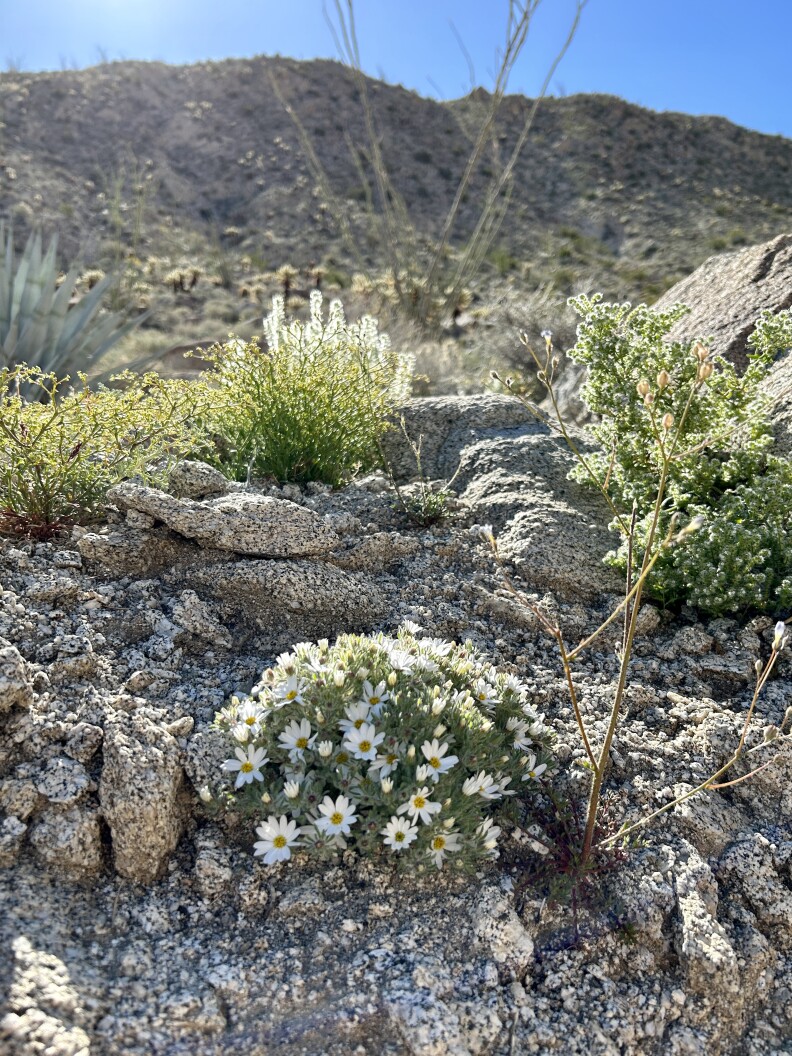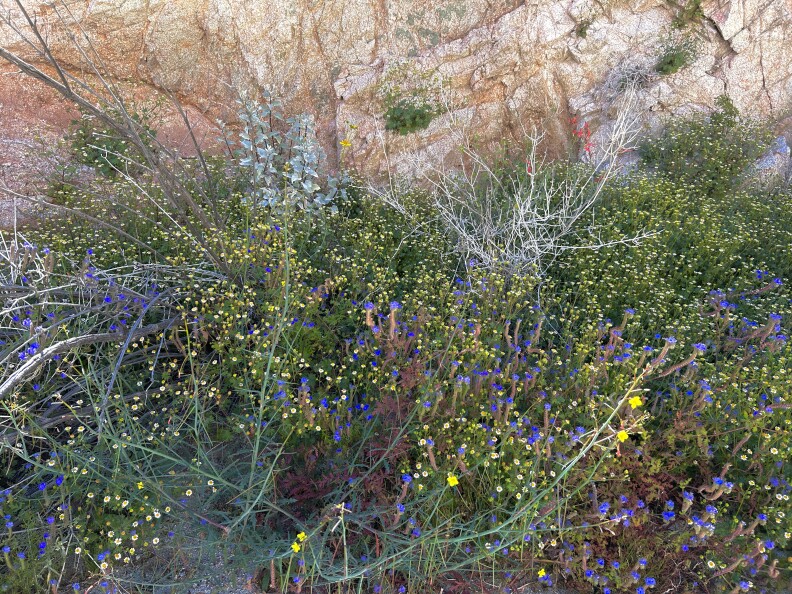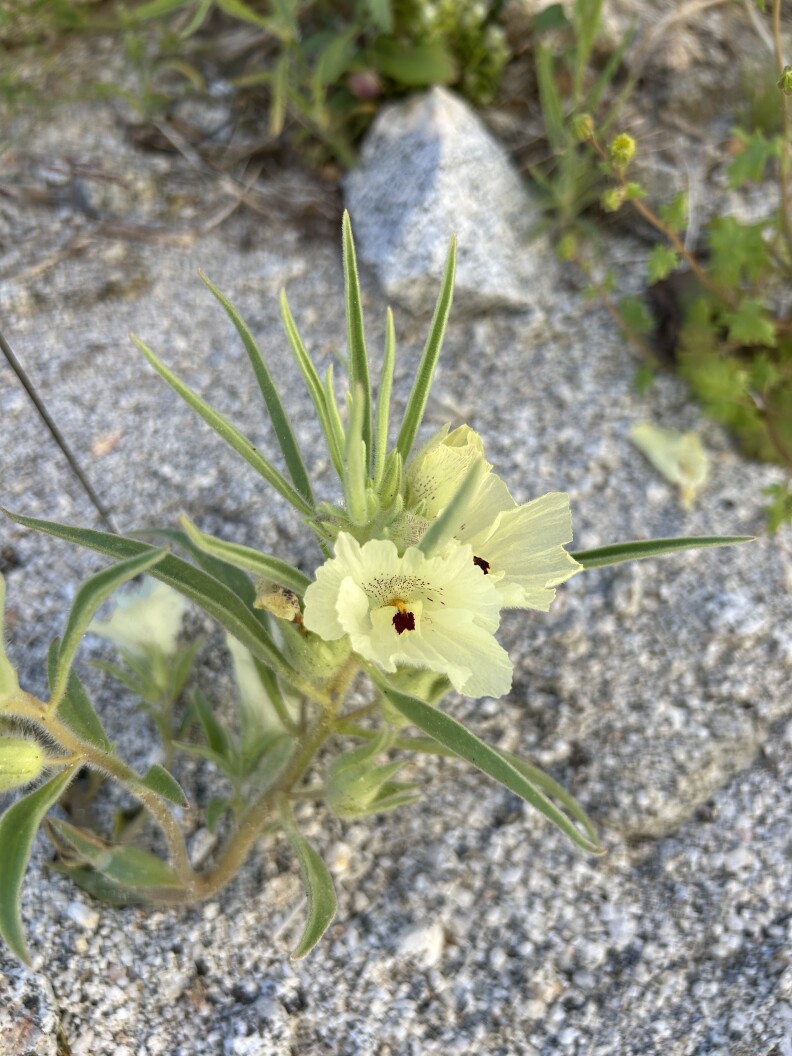I dare you to not take a million photos of wildflowers this spring. Dare you!

I hadn't planned to spend hours crouched on the sand last weekend, flipping through photo settings on my phone, trying to capture the Southern California desert in an abundance I had never seen before.
But I couldn't help myself. Who knows when we'll see such vibrance again in this recently drought-choked land?
It's not a super bloom, it's a constant bloom
I'm talking specifically about the desert in and around Anza-Borrego Desert State Park in San Diego County. Wildflowers have been blooming there, weirdly, all winter thanks to rain and cool temperatures in early fall.
But researchers told me late last year that they weren't sure whether flowers would still be blooming into their normal spring season. I can confirm, the blooms are still going strong — thanks to the continuous, abundant rain we've had in recent months.
"Instead of a 'super bloom' where everything goes to flower in a short period, we've had some sort of 'constant bloom,' where there has been activity all year," said Travis Huxman, a plant ecologist at the University of California, Irvine.
-
It's gonna be Yankees v the Boys in Blue
-
What candidates can — and can't — say they do
-
Nonprofit's launching fundraiser to keep it afloat
Rainfall has been much higher in and around Anza-Borrego this winter than average. In March, for example, the Western Regional Climate Center measured 2.32 inches of rainfall at its Anza-Borrego State Park station. In March of last year, it measured just 0.18 inches of rainfall.
Some desert plant experts were also worried that invasive species, like Sahara mustard, might eclipse the regular spring wildflower bloom. But that doesn't seem to be happening.
"There is no doubt that invasives have benefited from this [wet season] at least as much as the natives," Huxman wrote to LAist in an email. "Although I don't think I've seen the overwhelming mustard dominance I've seen in the past."
Huxman and others said that could be thanks to aggressive efforts to remove the plants, and to their die-off in recent drought years.
The right plant cues
The seeds of desert plants wait for specific cues to germinate, including rain and temperature, said UC Irvine's Sarah Kimball. Some species tend to come up every year. Others are pickier about conditions.
But this year, apparently, just about every desert plant seed has been coaxed out of dormancy.
Each spring, Kimball monitors plots of land near Anza-Borrego — 1-square meter each — for plant growth and diversity. Sometimes, there are no living plants in a plot, she said. This year, there were more than 1,000 living plants in one plot, including species she had never seen there before.
And it's not just wildflowers. Kimball said she's excited about all the baby desert shrubs that have popped up after years of watching them die off.
"I was starting to feel really worried for the future of the desert," she said. That's because shrubs create conditions, including shade, that help other plants, like wildflowers, grow.
"Once you have a mature shrub, it creates this little micro habitat under which lots of annuals live," Kimball said. Annuals, including most desert wildflowers, grow and die in a single growing season. So desert shrubs, though less showy, help wildflowers do their thing.

Why respecting the flowers is so important
A big wildflower season like this one comes with an unfortunate side effect — anxiety for local residents and for the people charged with managing sensitive ecosystems. In February, the city of Lake Elsinore closed Walker Canyon ahead of an expected massive bloom of California poppies. In 2019, hikers trampled flowers there and exhausted emergency responders.
Jim Dice, who manages UC Irvine's Anza-Borrego Desert Research Center, remembered the wildflower "superbloom" of 2017 that overwhelmed the small town of Borrego Springs near the park's entrance. "People were getting into fights in the restaurants. A couple of guys got into a punchout over a pork Cubano sandwich," he said.
The town and the park are now better prepared. "We are ready for the visitors and grateful for the coming onslaught," reads a post on the state parks department website.

Kimball hopes people will show respect for the delicate life cycle of desert wildflowers. "Think about, like, this plant came from this little seed that was sitting in the soil for years and this is its chance to set seed again and to produce offspring that will then replenish the seed bank," she said.
Those seeds will produce wildflowers for future springtimes. "We love and appreciate nature, and wildflowers are so important for all of our mental health, in addition to a healthy, functioning ecosystem," she said.
Kimball also wants people to think about what else it will take to make sure those future blooms happen — moving toward clean energy in order to slow climate change and protecting remaining open space, she said. "We know what we need to do to protect nature. … It's just a matter of getting our society to start doing that."
Flower viewing tips
-
Here's guidance from the California Botanic Garden on how to responsibly view the state's spectacular flower blooms:
-
- Stay on designated trails: real trails — not those newly blazed by the person before you.
- Take photos only; leave wildflowers where they are.
- Plant your own super bloom by sowing seeds from reputable nurseries such as the Grow Native Nursery at CalBG or Theodore Payne Foundation.
- Volunteer with organizations to help maintain native ecosystems.
- Avoid visiting the most vulnerable parks with high visitation (i.e., those that you may be hearing about on the news or social media). Instead, spread out to other areas. There is a lot to see in California!
- Share these guidelines with others: your friends, family, people you see violating them.
Where to see wildflowers
The Theodore Payne Foundation Wild Flower Hotline has weekly recorded reports every Friday through May. Those who give it a ring at 818 768-1802 extension 7 will hear information about where flowers can be viewed in Southern California.














